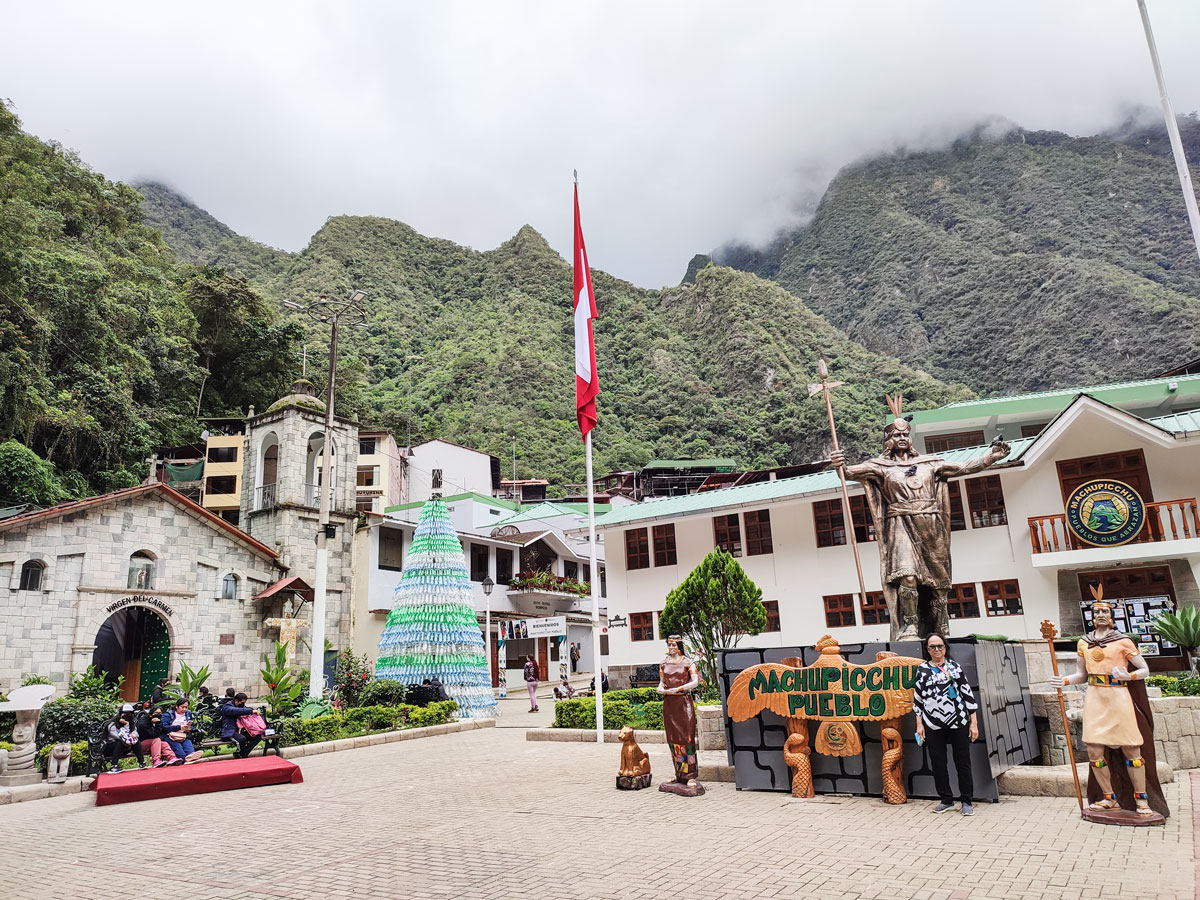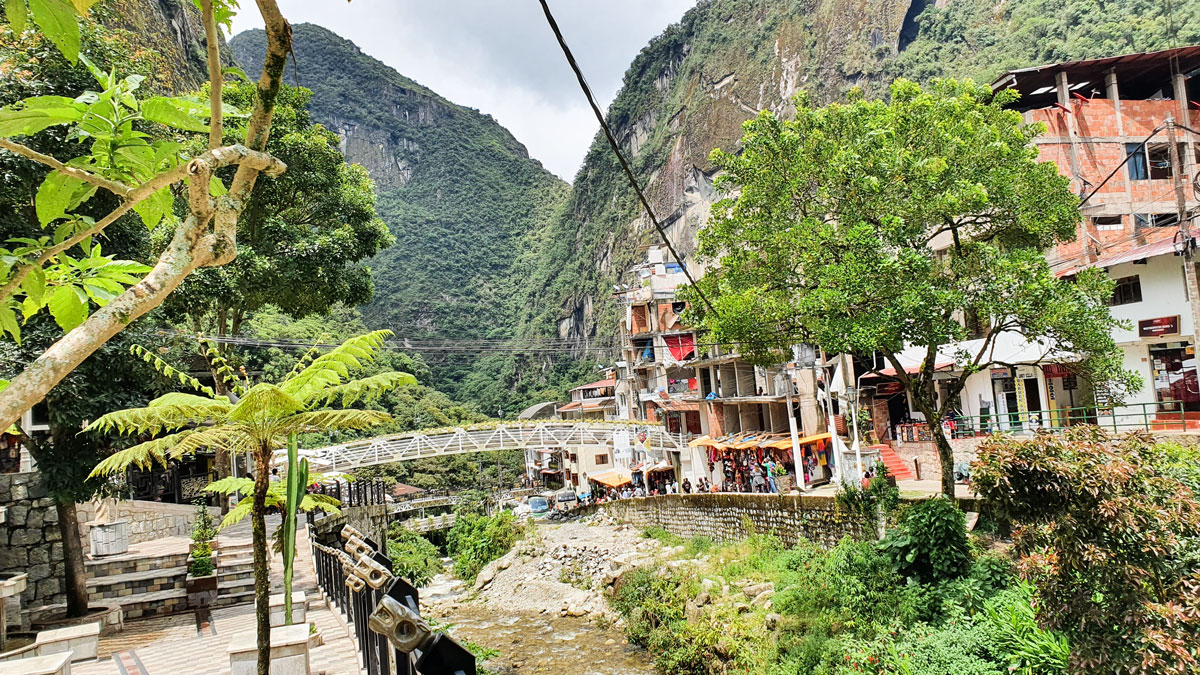Machu Picchu. The district of Machu Picchu is situated in Peru's South-East, in the Province of Urubamba-Cusco and located in Inter Andean valleys and mountains. Machu Picchu Village or Aguas Calientes (district Capital), lies 110km, from Cusco, at the foot of the mountain that shelters the Incan city of Machu Picchu, at the confluence of the Vilcanota , Aguas Calientes and Alccamayu rivers. The district's territory includes severeal ecological levels, from the jungle's edge. to the highlands and the Historical sanctuary of Machu Picchu part of that district.
In Aguas Calientes, there is a wide variety of tourist services, among which stand out lodgings, hotels, restaurants and souvenir shops which are only part of the increasing diversity of options available to the visitor, along with internet service, telephone booths, cafés, exchange agencies, ATM machines and portal serivices. Machu Picchu Village is really worth visiting after you got to know the Sanctuary. For those who have time to stay one day in the village, these are many options of alternative touristm. For example a Mariposario (butterfly natural reserve) has beem recently inagurated and is located only 15 minutes on foot from the village.

Handricraft Market
Machu Picchu Pueblo has the adequate infraestructure to offer commodity and security to its visitors, so that they might purchase handicraf in good conditions. The handicarf market, inagurated in 2003, has 28 sales stands, along with tourist information, restrooms, fluent pedestrian access and a direct connection with hotels and restaurants, as well as with the train and bus stations. In the handicraft works on offer in the handicraft market, quality stands out, as well as the originality and great diversity of the expression of Incan. Colonial and contemporaneous Art. the majority of the producers are located in Machu Picchu Village nad is farming communities and among the works on display, stand out objects in carved serpentine stone (original from the area), such as chacanas (Andean crosses), pumas, snakes and the condor are the most sought for items as souvenirs of the visit. Finally , artisans from Cusco, pisaq, Ollantaytambo, Chnchero, Q'orao, Puno and other parts of country, add up to this sample of local art.

Thermo- Medicinal Baths
800 meters t the East of Aguas Caliebntes (Machu Picchu Pueblo), are its famous thermal baths, recommedable for their healing properties, regulatory for the metabolism and high blood pressure, efficient for the elimination of toxins or simply good to relax in a peaceful atmosphere. In order to help you fully enjoy them, a service, tempratures. The baths are localted 15 minutes on foot from the village and opening hours are between to go very early, as the water is renewed every night.
Sites Museum And Botanical Gardens
The manuel Ballon Site Museum and the Botanical Gardens are located at the foot of the Incan City (Hight of Puente Ruinas) and the museum displays pieces of goldsmith work and ceramics lately discovered on the different sites of the Historical Sanctuary of Machu Picchu. Attention to the public is Monday through Sunday, from 9:00 a.m to 4:30 p.m. It is definitely worth visiting the excelent graphic exposition of the Andean culture that narrates the Sanctuary's history.
Putucusi's Vantagepoint
200 m. from Machu Picchu Village, there rises Mount Putucusi, from the top of which one visually dominates the Vilcanota Canyon, the City of Machu Picchu and the jungle all the way to the horizont. Climbing it takes about two hours, on vertical ladders nailed to the rock and a path surrounded by dense vegetation. This is the best place to enjoy a unique panoramic view of the whole region, from an almost flat rock platform idela for meditation and good vibes. The access is free, but if you suffer from dizziness, we recommend you not to go there, as its degree of dificultty is medium, but the very vertical aldders are a challenge as much for locals as for foreigners.
Mandor Waterfall
Aguas Calientes is below the citadel of Machu Picchu. A wide range of accommodation and restaurants form a real tourist oasis in the middle of the rainforest. A serpentine track leads up to the Inca site. Buses go uphill every few minutes, mostly full. You take on the dust and follow the track for about half an hour. At the bridge you take another photo of the Rio Urubamba, which flows into the Amazon, but you don't cross it. On the right a small staircase leads up to the train tracks. You now follow this further, sometimes on the rails, on the gravel, but mostly a beaten path leads parallel to it. First it goes through a wonderful botanical garden, where you will find various ornamental and useful plants lovingly prepared. After another hour through dense forest and rustic bird calls, you reach a small restaurant on the left. Here you can not only strengthen yourself but also pay admission. The path up to the waterfall leads slightly uphill opposite. Initially through plantations and signposted native vegetation, you soon find ourselves in dense jungle. After about thirty minutes you reached the Mandor waterfall.
Biodiversity
With an extension of 38,448 hertares, tahat area, protected by the Peruvian Satate and by the UNESCO that declared it humanity's Cultural Patrimony in 1982, Machu Picchu's Archaeological park shelters 34 archaeological complexes interconnected by an Inca Trail network and possesses a rich varietyb of species of flora and fauna. The abrup aspect of the area and its environmental configuration alow the existence of nine life zones. Its altitude ranges from 2,000 to 6,000 MAMSL and from high Andean and highland (Puna) to subtropical jungle edge areas, with their vast biodiversity and the Sanctuary's greates natural wealth is found in the humid areas, betwen 2,000 and 3,000 MAMSL.

Aguas Calientes to Machu Picchu hike
From Aguas Calientes the buses go up to Machu Picchu every few minutes. The eight-kilometer, winding journey takes just under half an hour. The sole provider for the bus rides is the company Consettur.
Aguas Calientes to Machu Picchu hike: You can also hike to Machu Picchu from Aguas Calientes. However, the sweaty ascent over steep steps and/or along the serpentine road takes about two hours. The hike is not recommended when it rains, as the ground is soggy and the steps are slippery.
Best hike to connect to Machupicchu town
Many are the routes that take you to Machu Picchu, but none is like the Inca Trail Tours, the most famous pedestrian path in the Americas. After flying from the capital of Perú, Lima, you will arrive in Cusco to walk for four days along a path through forests and dense fog, millenary stone steps and discovering the ruins of ancient fortifications and Inca cities, and all the time enjoying majestic views.
- Salkantay Trek to Machu Picchu 5 days
- 5 day Inca Trail Hike
- Inca Quarry Trail 4 Days
- 2 Day Inca Trail Tour
- 2 Day Inca Trail with Camping
- 3 Day Inca Trail
- Vilcabamba Hike to Machu Picchu 6 days
- Choquequirao trek to Machu Picchu 9 days
- Ausangate trek 7 days
If you want to visit Machu Picchu, we recommend you to book your Machu Picchu Ticket in advance, so you will enjoy your Vacation in Machu Picchu without any problem.

When is the best time to hike to Machu Picchu?
The best season is during the dry season, which covers the months April to the end of September. In October the rains begin and you can find Machu Picchu covered by clouds. If you travel in June, we recommend you to book the Inti Raymi 2025 Tour that takes place in June 24th, and also hike the Palcoyo Mountain Tour, which is an incredible Rainbow Mountain located in the Andes.






